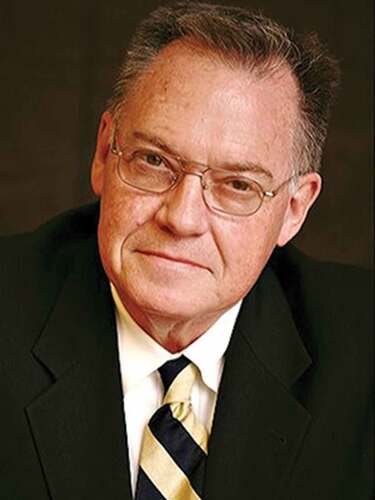Alan Linn Murphree, born in Houston, Mississippi on 6 June 1945, to Maxine Linn and John Alan Murphree, passed away in Pasadena, California, on 9 March 2022. He graduated from Houston High School in 1963 as valedictorian of his class. He attended The University of Mississippi, where he was president of Beta Theta Pi Fraternity and of Alpha Epsilon Delta, and was a member of the Rebel Band, Omicron Delta Kappa, Phi Kappa Phi, and Phi Eta Sigma. After graduating magna cum laude in 1967, he was chosen as a Fulbright Scholar to study human genetics at the University of Copenhagen in Denmark with Dr. Lars Jacobsen.
He entered Baylor College of Medicine in the fall of 1968, and received his M.D. degree in 1972. After a year of fellowship in genetics, he completed an ophthalmology residency at Baylor, serving as chief resident in 1975-76. He was awarded the Heed Fellowship in Ophthalmic Genetics and Pediatrics at the Wilmer Eye Institute, Johns Hopkins University School of Medicine in Baltimore, MD, in 1976-1977. He served as Captain in the United States Army Reserve Medical Corps, from August 1972, until June 1980, and was honorably discharged.
At the end of his fellowship at Johns Hopkins Hospital, he took on his first and only professional post when he assumed the Division Chief of Pediatric Ophthalmology position at Children’s Hospital of Los Angeles, University of Southern California School of Medicine.
Linn, as he was known, was a tremendous force in ocular oncology, recognized for his role in cloning the RB1 gene, and his passion and purpose for treating children with retinoblastoma.
With his first NIH grant, he demonstrated by deletion mapping that the RB1 gene was located on chromosome 13q14. Subsequently, he developed a clinical referral practice focused on pediatric ocular oncology and created the largest retinoblastoma referral center west of the Mississippi at CHLA—the Center continues to thrive. As a result of his clinical practice, Dr. Murphree recognized an unmet need for a wide-field retinal camera to document the intraocular findings associated with retinoblastoma. He recruited a team of optical engineers and collaborated with others in private industry to develop the RetCam®, a widely used and commercially available pediatric retinal camera that has facilitated the care of patients with retinoblastoma and other retinal diseases, including retinopathy of prematurity.
Dr. Murphree’s work on chemo-thermotherapy, published in 1983, laid the foundations for the treatment of retinoblastoma using intravenous chemotherapy combined with local therapies. Another one of his major contributions was the convening of an International Committee on the reclassification of intraocular retinoblastoma in 2003, a work that has resulted in the publication of the new gold standard IIRC classification of intra-ocular retinoblastoma in 2005. He is the author or co-author of more than 70 seminal papers on retinoblastoma genetics and clinical care. He received numerous accolades during his career, including the Ellsworth Lecture from the International Society for Genetic Eye Diseases and retinoblastoma (ISGEDR), a group he was instrumental in creating, in Whistler, Canada in 2005, the prestigious Stallard Award from the International Society of Ocular Oncology (ISOO) in Paris in 2015, and the Helen Keller Award for the impact of RB1 gene cloning in 2018.
Dr. Murphree enthusiastically participated in the first One Retinoblastoma World meeting hosted by WE C Hope, held in London, England, in 2012. He led the session “Psychosocial Care: Healing the Whole Child,” and presented research on Post Traumatic Stress in children treated for retinoblastoma. This work had been completed by his long-time colleague, Nancy Mansfield, founding Executive Director of the Institute for Families at CHLA, who died in 2010.
A Celebration of Life was held for Dr. Murphree on Saturday, May 14th, 2022, at All Saints Church in Pasadena. The church welcomed him when he moved to Pasadena and his home overlooked the church courtyard so even when he did not feel well enough to attend church, he heard the service go on. The reflections at his service were offered by two of his trainees, one of his first and one of his last fellows, Drs. Francis L. Munier and Jesse L. Berry. Dr. Munier shared, ”When I remember those [fellowship] days, I realize that he changed not only the course of my life, but also my way of thinking. He became my role model, a golden opportunity that cannot be stressed enough. An angel in the city of angels is what he was and will remain so for ever. I strongly believe that he has now joined the celeste army of angels in the sky of Los Angeles.”
Dr. Berry added, “People say that your work won’t be at your bedside when you pass. But that didn’t apply to Linn. His life work was more than his inventions, his publications, his stature in the field. His life’s work was about creating and fortifying families—in every single child he treated—he left a mark on their family too. His work surrounded him during in his life, and quite literally showed up to his bedside in his last days. I know how grateful he was for that. Because in all of you he saw his life continue on. In all of you he saw hope”
Dr. Murphree will be remembered with great affection and gratitude by hundreds of children, survivors, and their families for whom he cared deeply, and by the many physicians he trained now practicing around the world. He will always be an inspiration to those who strive to heal others.
This issue of Ophthalmic Genetics is dedicated to the memory of Linn Murphree and several groups of physicians and scientists have contributed the results of their work to be included in this festschrift.
Disclosure statement
No potential conflict of interest was reported by the author(s).

